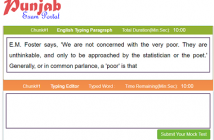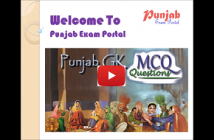Friends, below is the list of important MCQs of Biology(collected from previous years competitive exams papers). Specially Designed for Punjab Haryana High Court Exam. This list will be helpful for all upcoming Punjab Govt. Exam.Â
Q-1 Which one among the following vitamins is necessary for blood clotting?
(a) Vitamin A
(b) Vitamin D
(c) Vitamin KÂ
(d) Vitamin C
Q-2 In Opuntia, the spine is the modification of
(a) leafÂ
(b) Stem
(c) root
(d) None of these
Q-3 Organisms free floating on the surface of water body are
(a) benthos
(b) nektons
(c) neustons
(d) phytoplanktons
Q-4 The urine sample of a diabetic patient contains
(a) sucrose
(b) fructose
(c) glucose
(d) All of these
Q-5 Which of the following organism does not obey the cell theory?
(a) Virus
(b) Bacteria
(c) Fungi
(d) Plants
Q-6 When a colour blind male marries a normal woman not carrying the gene for colour blindness, their offspring will be
(a) normal sons and normal daughters
(b) normal sons and carrier daughters
(c) normal daughters and colour blind sons
(d) colour blind sons and carrier daughters
Q-7 In human body, the pancreas secretes its enzymes into which one of the following?
(a) Stomach
(b) Ileum
(c) Jejunum
(d) Duodenum
Q-8 Where is the organ of corti located?
(a) Internal earÂ
(b) Middle ear
(c) External ear
(d) None of these
Q-9 Hyper osmotic urine secreted by human beings is due to presence of depends on
(a) length of distal convoluted tubule
(b) width of Bowman’s capsule
(c) loop of HenleÂ
(d) length of proximal convoluted tubule
Q-10 Which one among the following parts of castor seed yields oil?
(a) Nucellus
(b) Ccaruncle
(c) Endosperm
(d) Cotyledon
Q-11 In the biotic interaction, both the species derive benefit and their association more or less obligatory is termed as
(a) proto-corporation
(b) symbiosis
(c) commensalism
(d) parasitism
Q-12 The gastrointestinal hormones namely secretin and cholecystokinin secreted by duodenal epithelium activate respectively which organs to discharge their secretions?
(a) Pancreas and gall bladder
(b) Gall bladder and stomach
(c) Pancreas and stomach
(d) Stomach and small intestine
Q-13 Ecdysone is secreted by
(a) moluscs
(b) birds
(c) reptiles
(d) insects
Q-14 The fossil of Archaeopteryx represents the evidence of origin of
(a) birds from reptilesÂ
(b) mammals from reptiles
(c) reptiles from amphibians
(d) mammals from birds
Q-15 The colour of the bile pigment is largely derived from
(a) undigested food
(b) breakdown of hemoglobin from worn-out cells
(c) xanthophylls
(d) bile salts
Q-16 The technique used for the separation of DNA fragments is
(a) Northern blotting
(b) Southern blotting
(c) Western blotting
(d) None of these
Q-17 Which of the following dentition is found in crocodiles?
(a) Acrodont
(b) Pleurodont
(c) Thecodont
(d) None of these
Q-20 Among the following which one is not an ape
(a) Gibbon
(b) Urangutan
(c) Gorilla
(d) Langur
Q-21 In which pair, both the organisms are ammonotelic?
(a) Man and Toad
(b) Frog and Man
(c) Salmander and Frog
(d) Salamander and Tadpole
Q-22 The technique of the development of fruits without fertilization is known as
(a) parthenogenesis
(b) parthenocarpy
(c) autogamy
(d) sporogamy
Q-23 The acidic character of DNA and RNA are due to
(a) purine bases
(b) pyrimidine bases
(c) sugar fragments
(d) phospheric groupÂ
Q-24 Which of the vitamins is essential for the red blood cell formation?
(a) Thiamine
(b) Folic acid
(c) Riboflavin
(d) Niacin
Q-25 Consider the following statements
I. Endoplasmic reticulum (ER) is called as “skeleton of cellâ€
II. ER is divided into three types according to presence or absence of ribosome.
III. Smooth ER is rich in actively protein secreting cells.
Which of the statements given above is/are correct?”
(a) Only 1Â
(b) I and II
(c) II and III
(d) Only III
Q-26 The colour of flower petals is due to the presence of
(a) xanthophyll
(b) anthocyaninÂ
(c) phycoerythrin
(d) carotene
Q-27 The meiosis cell division can be best studied in
(a) young stem
(b) root tip
(c) youm leaf
(d) young antherÂ
Q-28 The tusks of the elephants are modified
(a) molars
(b) premolars
(c) canines
(d) incisors
Q-29 The number of cell organelles in our body can be kept in control by which of the following organelle?
(a) Lysosome
(b) Golgi bodies
(c) Mitochondria
(d) Nucleus
Q-30 Which of the following stages is associated with the formation of chiasmata during meiotic cell division?
(a) Leptotene
(b) Zygotene
(c) Pachytene
(d) Diplotene
Q-31 Father of biology is
(a) AristotleÂ
(b) Birbal Sahni
(c) C Linnaeus
(d) Charles Darwin
Q-32 Which of the following cell organelle is found in a cell which is very active in protein synthesis?
(a) Mitochondria
(b) Chloroplast
(c) Lysosome
(d) Ribosome
Q-33 Which one among the following has haustoria or sucking roots?
(a) Orchids
(b) Mango
(c) Chestnut
(d) Cuscuta
Q-34 Interferon suppresses the pathogenic activity of
(a) bacteria
(b) fungus
(c) virus
(d) protozoa
Q-35 The female gametophyte of angiosperm is mostly
(a) seven-celled
(b) eight-celled
(c) eleven-celled
(d) twenty-celled
Q-36 Kidney stones are mainly formed by which of the following compound
(a) Sodium chloride
(b) Silicates
(c) Calcium bicarbonate
(d) Calcium oxalate
Q-37 Which of the following plant has exhibited viviparity phenomenon?
(a) Manginifera
(b) Rhizophora
(c) Betula
(d) Psidium
Q-38 The gastrointestinal hormones namely secretin and cholecystokinin secreted by duodenal epithelium activate respectively. Which organs to discharge their secretions?
(a) Pancreas and gall bladder
(b) Gall bladder and stomach
(c) Pancreas and stomach
(d) Stomach and small intestine
Q-39 Which one among the following is the major proteins involved in the production of antibodies?
(a) Albumins
(b) a-globulins
(c) P-globulins
(d) y-globulinsÂ
Q-40 Which of the following organelles is associated with ATP synthesis in cells?
(a) Ribosomes
(b) Lysosomes
(c) Nucleus
(d) Mitochondria





2 Comments
please can you send me all mcq acts pdf including noting and drafting on my email id..kaurtranum10@gamil.com
please send me all mcq of science.. thanks